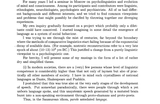Anonymous
7/11/2025, 5:52:58 PM No.24540600
Has anyone had the idea of applying a Fractal sort of lens to etymology?
>what does this mean
where meaning branches recursively, where each word-root is a seed—and every suffix, prefix, shift, and sound mutation is a branching pattern; not unlike how a fractal unfolds from a base function.
>Let’s define a recursive etymology structure:
If we start with a generic constructed root (from similar generic Proto-Indo-European roots, like *dher- / *dherə-, *dreu- / *drew-, or *tragh-; all of which describe "tensive motions")
We can use this Root "DRA"
Root: DRA (to draw / pull / unfold; A prefix indicating unfolding motion)
|
|-- Prefixes (direction, intent)
|-- Suffixes (tense, role, abstraction)
|-- Lexical Drift (semantic extension)
To construct words that could not be found anywhere in a modern dictionary, yet are as real and unique as any word found in one.
draith
(n) The trail or wake left by an unfolding thing (from DRA + -ith [abstract state])
“The draith of his thought lingered in the room.” = (the unfolding residue, like smoke or echo)
dranar
(n) One who draws out or evokes hidden things (DRA + -nar [agentive])
“The dranar entered the dream with wordless threads.” = (storyteller, psychoanalyst, codebreaker—any archetype of deep drawing)
endraw
(v) To draw something from within another thing (en- + DRA + w)
“She endrew his silence into song.” = (to tease out essence through subtle unfolding)
redrave
(v) To pull back toward origin; to rewind potential
(re- + DRA + ve [ve = move/flow])
“He redraved the future into past glimmers.”
>Summary of DRA:
Its simplicity (CVC (consonant-vowel-consonant) structure) makes it rootable in multiple directions: prefix, suffix, compound.
Its phonetic siblings (draw, drag, drain, druid, drama, dread, drape, dream) suggest a symbolic gravity well around acts of transition, revelation, and tension.
>what does this mean
where meaning branches recursively, where each word-root is a seed—and every suffix, prefix, shift, and sound mutation is a branching pattern; not unlike how a fractal unfolds from a base function.
>Let’s define a recursive etymology structure:
If we start with a generic constructed root (from similar generic Proto-Indo-European roots, like *dher- / *dherə-, *dreu- / *drew-, or *tragh-; all of which describe "tensive motions")
We can use this Root "DRA"
Root: DRA (to draw / pull / unfold; A prefix indicating unfolding motion)
|
|-- Prefixes (direction, intent)
|-- Suffixes (tense, role, abstraction)
|-- Lexical Drift (semantic extension)
To construct words that could not be found anywhere in a modern dictionary, yet are as real and unique as any word found in one.
draith
(n) The trail or wake left by an unfolding thing (from DRA + -ith [abstract state])
“The draith of his thought lingered in the room.” = (the unfolding residue, like smoke or echo)
dranar
(n) One who draws out or evokes hidden things (DRA + -nar [agentive])
“The dranar entered the dream with wordless threads.” = (storyteller, psychoanalyst, codebreaker—any archetype of deep drawing)
endraw
(v) To draw something from within another thing (en- + DRA + w)
“She endrew his silence into song.” = (to tease out essence through subtle unfolding)
redrave
(v) To pull back toward origin; to rewind potential
(re- + DRA + ve [ve = move/flow])
“He redraved the future into past glimmers.”
>Summary of DRA:
Its simplicity (CVC (consonant-vowel-consonant) structure) makes it rootable in multiple directions: prefix, suffix, compound.
Its phonetic siblings (draw, drag, drain, druid, drama, dread, drape, dream) suggest a symbolic gravity well around acts of transition, revelation, and tension.
Replies:


